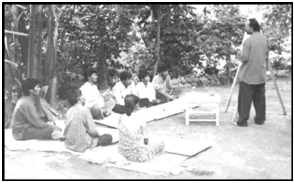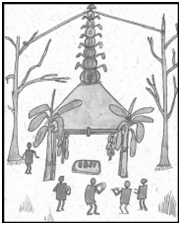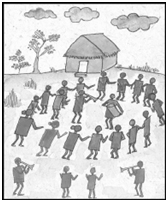KURUMBA PAINTING
2000 – 2001
Mr. Balaji, Research Scholar of the C.P. Ramaswami Aiyar Foundation, survey and catalogued the art traditions of the Kurumbas to have complete baseline data.
ActivitiesThe first phase took longer than expected. As the prospective trainees were illiterate and unused to even holding a pencil or brush, training had to be given in basics, before they could learn to adapt their traditional skills to modern materials.
Commercial Skills DevelopmentIn the course of the training, the tribal trainees could not understand the purpose behind the whole effort. Though the trainees were acquainted with the basic principles of their craft, they were complete novices to the nuances involved in making sophisticated art on paper, as preferred by the contemporary art customer. As it was felt that the trainees should be exposed to state of art in art, they were taken to various terracotta and art exhibitions and to craft shops and galleries.
ExhibitionIn order to acquaint the trainees with the of making contemporary art for commercial retailing, it was decided to hold an exhibition of the terracotta art ware and art made by them. The trainees had to understand the purpose of acquiring and upgrading their skills. An exhibition was organized at the C.P. Art Centre, 1 Eldams Road, Chennai – 600 018, in May 2000.
Training Of Kurumba Artists Shri. Kitna of Vellerikombu 5 kms trekking distance from Maamaram, situated around twenty-eight kms from Ooty, on Ooty – Kotagiri – Mettupalayam Road, working as a plantation labourer, had an ancestral knowledge of Kurumba art, art work with vegetable juices, red clay and coal powde r during festival days and local functions to decorate doorways, walls, etc. He is the grandson of the sole surviving artist of the Kurumba tribe. But very few other members of the Kurumba tribe seemed to be aware of the salient characteristics of their art.
Shri. Kitna of Vellerikombu 5 kms trekking distance from Maamaram, situated around twenty-eight kms from Ooty, on Ooty – Kotagiri – Mettupalayam Road, working as a plantation labourer, had an ancestral knowledge of Kurumba art, art work with vegetable juices, red clay and coal powde r during festival days and local functions to decorate doorways, walls, etc. He is the grandson of the sole surviving artist of the Kurumba tribe. But very few other members of the Kurumba tribe seemed to be aware of the salient characteristics of their art.
- The C.P.Ramaswami Aiyar Foundation Staff visited Velleri Kombu in Nilgiris for the selection of the trainer in January.
- The Kurumba Artist Trainer Kitna arrived and stayed at the C.P.Ramaswami Aiyar Foundation, Chennai in February.
- The Kurumba Artist was taught to draw with a pencil and paint on paper with the brush by artist Y. Venkatesh.
- He then recreated a variety of subjects on large sheets of paper.
The training then shifted to Velleri Kombu in the Nilgiris where 10 trainees were selected to be trained by the artist – trainer
Resource materials and infrastructure were provided by the Foundation- Easel
- Chart pads
- Brushes
- Paints
- Handmade papers
- Plastic sheets for preservation
- Lighting
- Trainees were chosen from the age group of 15 to 35 years.
- The trainees were encouraged to have initial art practice on chart papers.
- Later the trainees were encouraged to make simple greeting cards.
- The trainees began by devoting three hours a day at the workshop, till it became a full day of art.
The Foundation prepared a pamphlet relating the story of each of the Kurumba printings. The artist trainer actually painted during the exhibition on an easel. His art described tribal life in the Nilgiris. The Foundation invited the City’s prominent art enthusiasts, general public and leading newspapers to the exhibition. The invitation was printed with Kitna’s art. Newspaper advertisements were inserted.
There was a good response. The press interviewed the tribal trainers and came out with excellent reviews. Over 80% of the items were sold to the public. The rest were purchased by the Foundation.
Activities There were climatic deterrents which did not allow the progress of the training in the anticipated pace. The Kurumba youth had practical handicaps like inclement weather. They had to do their daily labour in a tea plantation or vegetable farm, as they could not discontinue their other commitments.
Initially the youth had to be given a number of chart paper sheets for practice sessions. The initial two to three months of training could only acclimatize their fingers to feel the paper through the touch of the brush.
It was a monumental effort as far as the Kurumba youth were concerned, as all along their fingers were used to the hard tasks of cutting wood, digging, weeding carrying bundles, tying ropes etc. It took some time for the tribal youth to acclimatize themselves to this task of a completely different nature.
There were climatic deterrents which did not allow the progress of the training in the anticipated pace. The Kurumba youth had practical handicaps like inclement weather. They had to do their daily labour in a tea plantation or vegetable farm, as they could not discontinue their other commitments.
Initially the youth had to be given a number of chart paper sheets for practice sessions. The initial two to three months of training could only acclimatize their fingers to feel the paper through the touch of the brush.
It was a monumental effort as far as the Kurumba youth were concerned, as all along their fingers were used to the hard tasks of cutting wood, digging, weeding carrying bundles, tying ropes etc. It took some time for the tribal youth to acclimatize themselves to this task of a completely different nature.
 During the training the trainees fully realized all the mistakes they could commit. This could be learned by trial and error and, most important, practice.
The Kurumba trainees made large art on handmade paper and boards, besides painted cards, notepad covers, etc. The choice of themes became more versatile as they gained confidence, and their choice varied from the vegetables and tubers to wedding function in their community. The depictions were of nature – trees and mountains, driving away bees while gathering honey, weddings and festivals. The solemnity of tribal life with prayers to the forefathers and communal participation at every stage of life was also brought out in the art.
During the training the trainees fully realized all the mistakes they could commit. This could be learned by trial and error and, most important, practice.
The Kurumba trainees made large art on handmade paper and boards, besides painted cards, notepad covers, etc. The choice of themes became more versatile as they gained confidence, and their choice varied from the vegetables and tubers to wedding function in their community. The depictions were of nature – trees and mountains, driving away bees while gathering honey, weddings and festivals. The solemnity of tribal life with prayers to the forefathers and communal participation at every stage of life was also brought out in the art.
